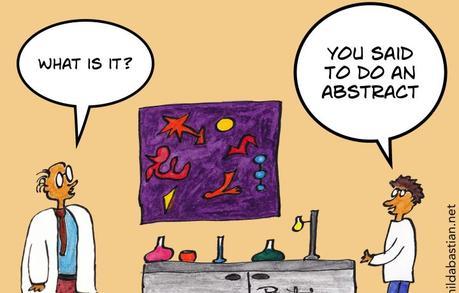
When you present a research paper, there is one part that has to grasp its essence in a short format: the abstract. It's the first thing the professor is going to read, so it gives you a chance to grab their attention by explaining what exactly this paper is going to be about.
The abstract is usually the last part of the writing process. Once you have the entire paper done, it's difficult to explain what it's about in few brief paragraphs. That being said, students often present poorly-written abstracts, which convey biased opinions, lack important details, or circle around the thesis statement without making precise claims. We are going to change that.
The point of the abstract is to present your paper as something worthy of the reader's attention. We will give you few tips that will help you achieve that impression.
Let's Make It Clear: What's an Abstract?
Before you can write the perfect abstract, you need to understand what this part of the research paper is all about. In its simplest definition, the abstract is a summary of the main points of the research paper. It's usually written in a single paragraph, so you'll have a lot of information to squeeze into few comprehensive sentences. Of course, you may write an abstract of 1,000 words if you have an extremely complex research paper to introduce, but this section usually takes from 200 to 350 words.
In essence, the abstract is like an outline of the paper. It should clearly describe your work, grasp the main theme of the project, and explain why this piece is useful for the academic or scientific community.
Useful Examples
The definition of a research paper abstract won't do you any good if you observe it from a theoretical point of view. You'll know what to include in it, but you might find it difficult to make the abstract captivating even if it contains all necessary information. That's why you'll benefit from observing few useful examples.
Did you know that Protein Measurement with the Folin Phenol Reagent was one of the most cited research papers of all time? It was written in 1951, but it's still a relevant example of how an extraordinary research paper should look like. Let's observe its abstract. You'll notice that in the beginning of the paper, the authors use brief paragraphs and comprehensive sentences. Although the thesis statement here is complex, the writers found a way to present it in a way that an average reader could understand. This abstract explains why research of this type was needed, and what it resulted with.
Here is another popular research paper with a successful abstract: A Rapid and Sensitive Method for the Quantitation of Microgram Quantities of Protein Utilizing the Principle of Protein-Dye. Now that's a long title, but let's take a look at the abstract. It gets straight to the point with the first sentence: "A protein determination method which involves the binding of Coomassie Brilliant Blue G-250 to protein is described." Then, the authors briefly expose the methods and results in a single paragraph.
We can learn a lot from these two examples: the abstract should be brief and comprehensive, regardless of the complexity and length of the paper. When an average reader runs into the paper, they should understand the abstract even if they have no previous knowledge on the topic.
You'll notice that these authors used passive language in the abstract. If you read online guides on how to write a research paper, one of the main recommendations will be to use active and avoid passive as much as possible. In fact, passive language is useful in the abstract, since it puts the emphasis on the information instead of the author.
The Features of a Great Abstract
Keep these qualities in mind when you're writing the abstract of your research paper:
- The paragraphs should be well-structured, clear, and unified. Read a single paragraph of your abstract. Can it stand alone as a separate part of the paper? That's the effect you want to achieve.
- The point of writing an abstract is to present the purpose of the research paper, its results, conclusions, and the recommendations it ends with.
- The abstract does not add new information; it just presents the research paper.
- This part of the paper logically connects all points of the content the reader is about to access.
- The abstract should follow the chronology of your research paper.
- It should be comprehensive not only for your target audience, but for an average reader as well.
How to Write a Great Abstract
There is one important thing to remember: you have to write, edit, and proofread the research paper, first. The abstract explains what the research paper is about, so you need that foundation in order to summarize it in the perfect abstract. Although it's the first part of the paper, you write it after finishing all other sections. Now that we got that out of the way, let's see how you can write the perfect abstract.
- Read the final version of your research paper once again. This time, keep the goal of writing the abstract in mind. What are the most important points of the paper? Note them down as you read. Remember: the abstract does not explain the different sections of the research paper; it provides a general summary.
- Keep these points in mind as you read the research paper: purpose, method, scope, results, your conclusions, and the recommendations the paper ends with.
- Write the first draft, making sure you include all important points in it. However, don't make it too long. Do not introduce new information and do not put in too much information. Do not rephrase the title; the abstract should summarize the research paper in a new way that doesn't sound repetitive.
- Include these sections in the abstract:
- Background - what other researchers have found about the subject in question. What details are still not known?
- Methods - explain what you have done and how you came down to the results you present.
- Results - present the findings of the research process as briefly and as clearly as possible.
- Conclusions - what's the highlight of the study and its take-home message?
- Don't forget to edit the abstract. Get rid of all unnecessary and repetitive words. This section needs to be very readable.
You Can Do It!
The challenge of writing a great abstract may seem overwhelming. However, keep in mind that this is the last thing you do before finally presenting the research paper. You already have the foundation; you just need to compress all that information into a readable format and explain what the reader is going to get. The above-listed tips and explanations will guide you in the right direction.

